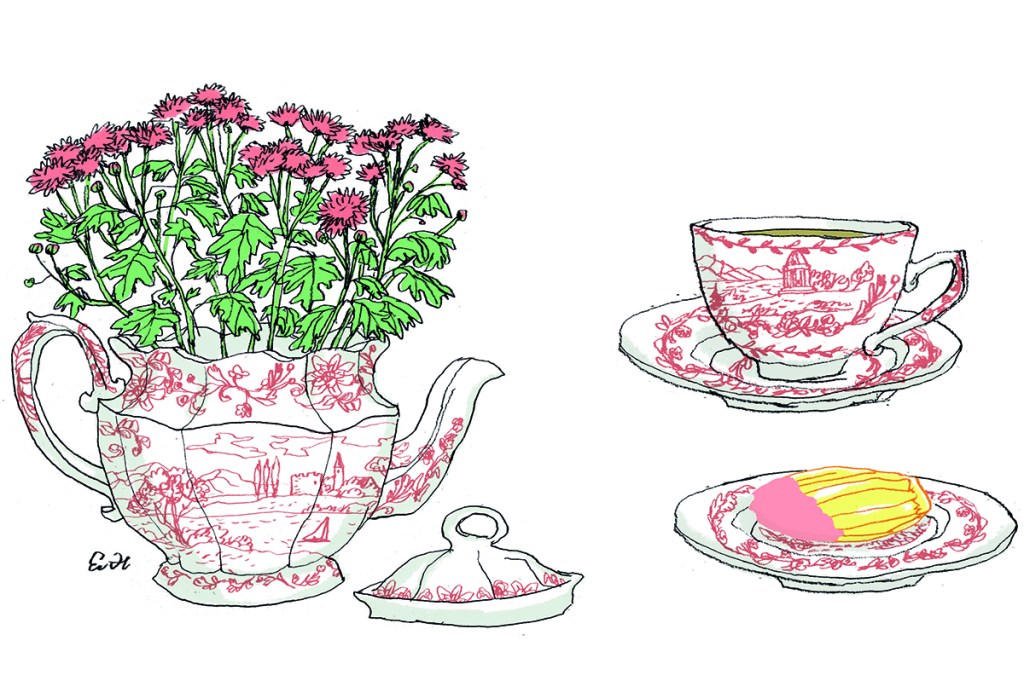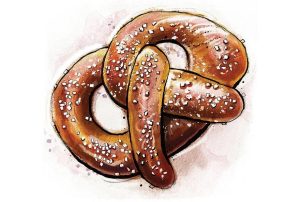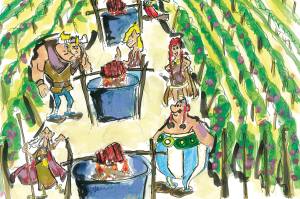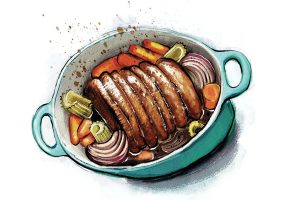In early October I bought three chrysanthemum plants to brighten my front doorstep during the gloomy days here in Montecito, California. The outdoor plant stand at Trader Joe’s, overflowing with a panoply of colored mums, reminded me how I love seeing French flair flourish when decorating with these seasonal blossoms. How, for a decade, I’ve been sharing and creating recipes with my daughter, a wine executive, with chrysanthemum flowers from her local organic épicerie and leaves discovered in a Burgundian marché.
In Burgundy, as in the rest of France, mums are displayed for Toussaint (All Saints’ Day) on November 1, and for Armistice Day, to mark the end of World War One. On the 11th day of the 11th month at the 11th hour in 1919, Georges Clemenceau called upon the French to decorate the tombs of fallen soldiers. The mum was chosen because it was one of the few plants flowering at that time of the year.
Toussaint is not a biblical holiday but a Catholic solemnity honoring the saints, known and unknown. French cemeteries in November burst with colored chrysanthemums as the nation mourns its deceased family members and heroes. If you’re so lucky as to be in France during October and November, your eye is constantly enchanted by how the French decorate store windows, window boxes and dining tables with mums and savoir faire; The French buy more than 23 million of the plants from 9,000 cultivators.
Apart from their role in national fêtes, colored mums are offered as symbols: yellow for perfection, red for intense love, white for pure love, pink for infatuation that could turn into real love. It is said in France that if one dreams of mums, one is waiting for love and marriage.
The first symbolic use of mums may date back to around 1,500 BC in China, where the flower symbolized nobility and hardiness and was given to families who had a newborn. Its boiled roots make a calming tea or a treatment for headaches. Its petals are added to salads. As a ritual, nectar from the petals is served on the ninth day of the ninth moon during an autumn festival known as the Double Nine.
Only the Japanese outdo the French and Chinese in their adherence and affection for the mum. In Japan, mums have been cultivated since the 8th century, when they were chosen as the imperial symbol, representing the sun. The flower adorns the country’s flag and all pertaining to the empire. The emperor sits on the Chrysanthemum Throne. During World War Two, kamikaze pilots used the mum as their symbol. The Order of the Chrysanthemum is the highest medal awarded for bravery. Ikebana, the Japanese art of flower arranging, often uses mums. In November, in Bunkyô, a suburb of Tokyo, the annual Chrysanthemum Festival exhibits mums from over 2,000 varieties. Japan claims to have developed 350 of the approximately 20,000 known varieties.
For Americans, chrysanthemums simply signal the beginning of fall and the harvest. This seemingly boring and inexpensive flower lasts through Christmas, filling vases at Thanksgiving to focus the eye on fall’s subtle, yet lusciously striking colors. In fact, mums are anything but boring. And they are edible, as I learned in France.
Beaune, 15 minutes from my family’s home at Meursault, begins its assault on the senses with mum blossom bounty in early October. It’s a town with immense medieval charm, tiled Burgundian roofs reflecting the myriad colors one finds in chrysanthemums. It was there on a Saturday morning that I discovered a marchand’s basket overflowing with crenelated mum leaves that would make a tangy pesto for that evening’s supper, beginning another family tradition for Saturday nights.
During my annual visit, Annabelle and I made dainty chrysanthemum madeleines from ground blossoms. Granddaughter Maëlle helped to dip them in the melted pink chocolate; Maëlle loves pink. Perhaps we started this tradition as a homage to Marcel Proust’s Remembrance of Things Past and 46 years of mother/daughter kitchen memories. The petits gâteaux (the French consider madeleines cakes not cookies) with the soupçon of chocolate ganache elevating the fabled délice to a visual and gustatory level which would have made the fabled French author’s lips sing.
The last time I made madeleines with my daughter and granddaughter was in 2019. Not wanting to step on a family tradition, and having discovered that I could buy ground chrysanthemum blossoms at Whole Foods, I found a recipe for honey chrysanthemum shortbread cookies. I’ve been making these tender, buttery cookies for friends and neighbors as a way to keep conversations going over gates as we are hunkered down in our houses.
I’m thinking of making a light, aromatic Japanese chrysanthemum cheesecake recipe for this Thanksgiving, if dear friends, we feel safe enough from COVID-19 to celebrate American bounty. Perhaps another tradition will be born, thanks to chrysanthemums.
Madeleines
Ingredients
Dry: 1 cup plus 1 tbsp whole wheat flour, 4 tbsp ground chrysanthemum powder, 1 tsp baking powder
Wet: ½ cup almond milk, ⅓ cup agave syrup, 1 tbsp lemon zest, 2.5 oz. vegetable oil, 1 tsp lemon juice, 1 tsp vanilla bean paste
Chocolate Ganache: 1 oz dark chocolate, 2 oz ruby chocolate, chopped pistachios
Directions
- Preheat oven to 350°F. Grease pan with butter. In a large bowl, sift flour and baking powder. In another bowl, add milk and syrup and whisk until well combined. Add oil, lemon zest, lemon juice, ground chrysanthemum leaves and vanilla. Whisk to combine
- Pour the wet mixture over the dry and whisk until just combined. Using an ice cream scooper or a spoon, scoop the batter into the prepared pan. Bake for 10-15 minutes, until a toothpick comes out clean
- Allow madeleines to cool in the mold for five minutes, then gently flip them on the side to cool completely. (This will prevent flattening the beautiful and typical bumps on the madeleines’ backs)
- For the ganache, gently melt the white and pink chocolate over a bain Marie, stir to combine and let cool down to room temperature
- Dip the madeleines into the chocolate and chopped pistachios and place on a grid to remove the excess
Chrysanthemum Leaf Pesto
Ingredients
1 bunch of chrysanthemum leaves (3½ oz), ¼ cup roasted pine nuts, 1 large minced garlic clove, ¼ cup grated Parmesan cheese, ⅓ to ¼ cup olive oil, salt and ground pepper
Directions
- Bake pine nuts in a 350°F oven until lightly golden (about 20 minutes)
- Wash chrysanthemum leaves. Blanch them in boiling water and them dip in cold water to stop cooking further. Drain well, squeeze to remove excess water, then chop up. (If you want a tangier flavor, you can use leaves without blanching them.)
- Place toasted pine nuts, leaves, garlic, Parmesan cheese and salt and pepper in food processor, gradually adding until well combined.
This article was originally published in The Spectator’s November 2021 World edition.


















